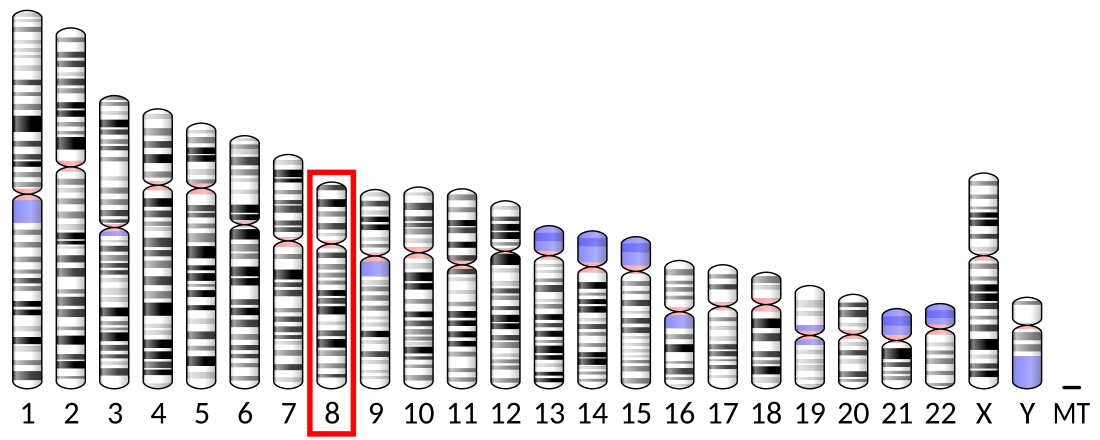LYNX1
Protein-coding gene in the species Homo sapiens From Wikipedia, the free encyclopedia
Ly6/neurotoxin 1 is a protein in humans that is encoded by the LYNX1 gene.[5] Alternatively spliced variants encoding different isoforms have been identified.
| LYNX1 | |||||||||||||||||||||||||||||||||||||||||||||||||||
|---|---|---|---|---|---|---|---|---|---|---|---|---|---|---|---|---|---|---|---|---|---|---|---|---|---|---|---|---|---|---|---|---|---|---|---|---|---|---|---|---|---|---|---|---|---|---|---|---|---|---|---|
| |||||||||||||||||||||||||||||||||||||||||||||||||||
| Identifiers | |||||||||||||||||||||||||||||||||||||||||||||||||||
| Aliases | LYNX1, SLURP2, Ly6/neurotoxin 1 | ||||||||||||||||||||||||||||||||||||||||||||||||||
| External IDs | OMIM: 606110; MGI: 1345180; HomoloGene: 8026; GeneCards: LYNX1; OMA:LYNX1 - orthologs | ||||||||||||||||||||||||||||||||||||||||||||||||||
| |||||||||||||||||||||||||||||||||||||||||||||||||||
| |||||||||||||||||||||||||||||||||||||||||||||||||||
| |||||||||||||||||||||||||||||||||||||||||||||||||||
| |||||||||||||||||||||||||||||||||||||||||||||||||||
| |||||||||||||||||||||||||||||||||||||||||||||||||||
| Wikidata | |||||||||||||||||||||||||||||||||||||||||||||||||||
| |||||||||||||||||||||||||||||||||||||||||||||||||||
Function
Summarize
Perspective
This gene encodes a member of the Ly-6/neurotoxin gene family, a group of lymphocyte antigens that attach to the cell surface by a glycosylphosphatidylinositol anchor and have a unique structure showing conserved 8-10 cysteine residues with a characteristic spacing pattern. Functional analysis indicates that this protein is not a ligand or neurotransmitter but has the capacity to enhance nicotinic acetylcholine receptor function in the presence of acetylcholine. This gene may also play a role in the pathogenesis of psoriasis vulgaris.[5]
The LYNX1 gene codes for a protein (Lynx1) that binds to acetylcholine receptors in the brain.[6] Lynx1 a member of the Ly6 superfamily of proteins that are capable of modulating neurotransmitter receptors.[7]
Lynx1 and Visual Plasticity
Transgenic mice without Lynx1 expression do not have a normal critical period of neuroplasticity in the visual cortex for development of ocular dominance columns.[8] These mice show unusually rapid recovery from amblyopia in adulthood indicating a role in reduction of synaptic plasticity during the normal expression of Lynx1 in adult brain.[6]
Lynx1 reduces adult visual cortex plasticity by binding to nicotinic acetylcholine receptors (NAchR) and diminishing acetylcholine signaling.[9] After the developmental critical period and into adulthood, both Lynx1 mRNA and protein levels increase in the adult V1 and the lateral geniculate nucleus (LGN).[9] Lynx1 and nAChR mRNAs are co-expressed in the LGN, as well as in parvalbumin-positive GABAergic interneurons.[9] After monocular deprivation during the critical period to induce amblyopia, Lynx1 knock-out rat models spontaneously recovered normal visual acuity by reopening the closed eye.[9] Similarly, an infusion of physostigmine to increase acetylcholine signaling prompted recovery from amblyopia in wild type mice[9] Inhibition of Lynx1 may be a possible therapeutic mechanism to prolong synaptic plasticity of the visual cortex and improve binocular function of some amblyopes.
See also
Other Ly6 family proteins that are expressed in the brain: Lynx2, LYPD6, LYPD6B and PSCA.[6]
References
Wikiwand - on
Seamless Wikipedia browsing. On steroids.




